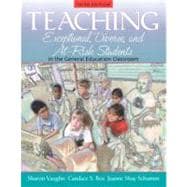
| Special Education and Inclusive Schooling | |
| IDEA and the Vocational Rehabilitation Act | |
| Responsibilities of Classroom Teachers | |
| Role of Collaboration in Meeting Students'' Special Needs | |
| Inclusion | |
| Teaching Students with Learning Disabilities or Attention Deficit Hyperactivity Disorder | |
| Learning Disabilities | |
| Definitions and Types of Learning Disabilities | |
| Characteristics of Students with Learning Disabilities | |
| Prevalence of Learning Disabilities | |
| Identification and Assessment of Students with Learning Disabilities | |
| Instructional Techniques and Accommodations with Students with Learning Disabilities | |
| Attention Deficit Hyperactivity Disorder | |
| Definitions and Types of Attention Deficit Hyperactivity Disorder | |
| Characteristics of Students with Attention Deficit Hyperactivity Disorder | |
| Prevalence of Attention Deficit Hyperactivity Disorder | |
| Identification and Assessment of Students with Attention Deficit Hyperactivity Disorder | |
| Instructional Guidelines and Accommodations for Students with Attention Deficit Hyperactivity Disorder | |
| Teaching Students with Communication Disorders and with Pervasive Developmental Disorders | |
| Communication Disorders | |
| Prevalence of Communication Disorders | |
| Identification and Assessment of Students with Communication Disorders | |
| Instructional Guidelines and Accommodations for Students with Communication Disorders | |
| Pervasive Developmental Disorders | |
| Prevalence of Pervasive Developmental Disorders | |
| Identification and Assessment of Students with Pervasive Developmental Disorders | |
| Instructional Guidelines and Accommodations for Students with Pervasive Developmental Disorders | |
| Addressing Challenging Behaviors | |
| Teaching Students with Emotional and Behavioral Disorders | |
| Definitions of Emotional and Behavioral Disorders | |
| Prevalence of Students with Emotional or Behavioral Disorders | |
| Types and Characteristics Emotional or Behavioral Disorders | |
| Causes of Emotional and Behavioral Disorders | |
| Identification and Assessment of Students with Students with Emotional and Behavioral Disorders | |
| Teaching Guidelines and Accommodations for Students with Emotional or Behavioral Disorders | |
| Teaching Students with Mental Retardation and Severe Disabilities | |
| Definition and Types of Mental Retardation and Severe Disabilities | |
| Prevention of Mental Retardation | |
| Prevalence of Mental Retardation and Severe Disabilities | |
| Characteristics of Students with Mental Retardation and Severe Disabilities | |
| Identification and Assessment of Students with Mental Retardation and Severe Disabilities | |
| Instructional Guidelines and Accommodations for Teaching Students with Mental Retardation and Severe Disabilities | |
| Teaching Students with Visual Impairments, Hearing Loss, Physical Disabilities, Health Impairments, or Traumatic Brain Injury | |
| Students with Visual Impairments | |
| Definition and Types of Visual Impairments | |
| Characteristics of Students with Visual Impairments | |
| Prevalence of Visual Impairments | |
| Identification and Assessment of Students with Visual Impairments | |
| Instructional Guidelines and Accommodations for Students with Visual Impairments | |
| Students with Hearing Loss | |
| Definition and Types of Hearing Loss | |
| Characteristics of Students with Hearing Loss | |
| Prevalence of Hearing Loss | |
| Identification and Assessment of Students with Hearing Loss | |
| Instructional Guidelines and Accommodations for Students with Hearing Loss | |
| Students with Physical Disabilities and Health Impairments | |
| Definition and Types of Physical Disabilities and Health Impairments | |
| Prevalence of Physical Disabilities and Health Impairments | |
| Characteristics of Students with Physical Disabilities and Health Impairments | |
| Identification and Assessment of Students with Physical Disabilities and Health Impairments | |
| Instructional Guidelines and Accommodations for Students with Physical Disabilities and Health Impairments | |
| Planning and Grouping Strategies for Special Learners | |
| Model of the Planning Process | |
| Long-Term Planning | |
| Unit Planning | |
| Lesson Planning | |
| An Overview of Instructional Grouping | |
| Grouping Patterns | |
| Managing Student Behavior | |
| Basic Principles of Managing Student Behavior | |
| Establishing the Classroom Climate | |
| Practices for Providing Positive Be | |
| Table of Contents provided by Publisher. All Rights Reserved. |
The New copy of this book will include any supplemental materials advertised. Please check the title of the book to determine if it should include any access cards, study guides, lab manuals, CDs, etc.
The Used, Rental and eBook copies of this book are not guaranteed to include any supplemental materials. Typically, only the book itself is included. This is true even if the title states it includes any access cards, study guides, lab manuals, CDs, etc.